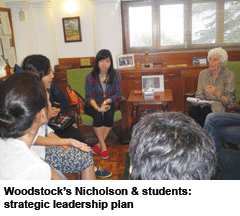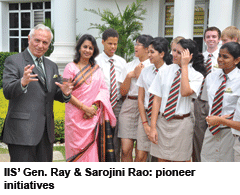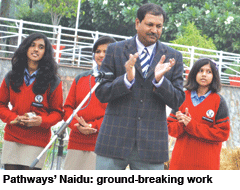In this glamour segment of K-12 education, the vintage Woodstock School, Mussoorie, which topped the table for two consecutive years (2008 and 2009), has regained its No. 1 position Summiya Yasmeen reports
 Capital-intensive new genre international schools benchmarked with the best residential primary-secondaries worldwide consti-tute the glamour segment of the Indian school system. Offering superior infrast-ructure, en suite residential accommo-dation, latest classroom technologies and a wide mix of co-curricular and sports and games facilities, India’s high-end international schools affiliated with offshore examination boards such as the International Baccalaureate Organisation (IBO), Geneva; Cambridge International Examination (CIE); Edexcel, UK and Advanced Placement (AP), have captured the imagination of post-liberalisation India’s upper crust, and increasingly of a growing number of foreign households as well. They offer world-class school education at a fraction of the fees demanded by Eton, Winchester and Andover with the additional advantage of climates that permit year-round outdoor activities.
Capital-intensive new genre international schools benchmarked with the best residential primary-secondaries worldwide consti-tute the glamour segment of the Indian school system. Offering superior infrast-ructure, en suite residential accommo-dation, latest classroom technologies and a wide mix of co-curricular and sports and games facilities, India’s high-end international schools affiliated with offshore examination boards such as the International Baccalaureate Organisation (IBO), Geneva; Cambridge International Examination (CIE); Edexcel, UK and Advanced Placement (AP), have captured the imagination of post-liberalisation India’s upper crust, and increasingly of a growing number of foreign households as well. They offer world-class school education at a fraction of the fees demanded by Eton, Winchester and Andover with the additional advantage of climates that permit year-round outdoor activities.
In this glamour segment of K-12 education, the vintage Woodstock School, Mussoorie (estb.1852), which was bested by Kodaikanal International School (KIS) in the international schools league table of 2010 after occupying the top spot for two consecutive years (2008 and 2009), has regained its No.1 position this year.
With an ever increasing number of primary-secondary schools across the country describing themselves as ‘international’, for the purposes of the annual EW-C fore surveys, international schools are defined as institutions which offer the syllabuses and curriculums of foreign examination boards, namely IBO, Geneva; CIE and Edexcel, UK and The College Board, USA from at least middle school (class VIII). Moreover, with a growing number of international schools also offering their students the option of a national exam board (CISCE or CBSE) curriculum, only those K-12 schools with more than one-fifth of the students body enroled in the inter-national programme are classified as international. “This reclassification enabled survey respondents to evaluate international schools on an equal footing,” explains Premchand Palety, chief executive of C fore.
Accredited by the US-based Middle States Association of Colleges and Secondary Schools and offering the American High School Diploma to its 500 students, Woodstock has been top-rated on the newly introduced para-meter of ‘international characteristics’ (expatriate staff, students and foreign connections), individual attention to students and sports education. “We are delighted that Woodstock has regained its position as India’s No.1 international school, especially on account of being ranked first on the parameters of international characteristics and individual attention to students. Our top rank in sports education can in part be attributed to the inauguration of our new state-of-the-art $1.5 million (Rs.6.75 crore) gym last year — funded and built by Woodstock alumni. However, we will not rest on our laurels and we are actively engaged in a strategic planning process — 2020 Vision — to ensure we continue to be leaders in international education in Asia,” says Dr. Eleanor Nicholson, pro tem principal of the school.
An alumna of Loyola and Chicago universities with over three decades of experience in teaching and school administration, Nicholson is holding fort until Jonathan Long, currently principal of the Mahindra United World College of India, Pune (ranked No.3), takes charge as principal of Woodstock in December.
Perhaps the highlight of the EW-C fore India’s Most Respected Schools Survey 2011 is that the three-year duopoly of Woodstock and Kodaikanal International at the head of the inter-national top table has been seriously challenged, if not quite ended, by the Bangalore-based new genre Indus International School (IIS), co-ranked second this year. In particular, there’s considerable jubilation within IIS that this IBO, Geneva-affiliated K-12 school has trumped the country’s more than century old Woodstock and KIS on the newly introduced parameters of teacher welfare and development and comm-unity service, in addition to co-curricular education and leadership/management quality.
 “We are elated that IIS is moving up in every survey. It’s a reaffirmation that we are on the right path, and motivates and inspires us to give our best. I am also delighted with our premier rating on community service. In the same year, we started our Indus International Community School, the country’s first equal opportunity school which offers free IB education to underprivileged students in our neighbourhood. Last year we also inaugurated our Indus Training and Research Institute, which in collaboration with Keele University, UK offers a postgrad diploma progra-mme in teacher development. I’m thrilled these pioneer initiatives are reflected in the survey,” says Sarojini Rao, principal of IIS, who is also elated about the swift rise into the Top 10 list of IIS, Hyderabad (estb.2008), ranked No.12 last year. “We hope our new IIS Pune which admitted its first batch of students in 2008 will be ranked next year,” she adds.
“We are elated that IIS is moving up in every survey. It’s a reaffirmation that we are on the right path, and motivates and inspires us to give our best. I am also delighted with our premier rating on community service. In the same year, we started our Indus International Community School, the country’s first equal opportunity school which offers free IB education to underprivileged students in our neighbourhood. Last year we also inaugurated our Indus Training and Research Institute, which in collaboration with Keele University, UK offers a postgrad diploma progra-mme in teacher development. I’m thrilled these pioneer initiatives are reflected in the survey,” says Sarojini Rao, principal of IIS, who is also elated about the swift rise into the Top 10 list of IIS, Hyderabad (estb.2008), ranked No.12 last year. “We hope our new IIS Pune which admitted its first batch of students in 2008 will be ranked next year,” she adds.
 Another new genre international school which is obviously making waves within the small but growing fraternity of international schools is the Gurgaon-based IBO, Geneva-affiliated Pathways World School, which has advanced in the national league table to No. 7 (10) and is top-ranked again under the parameter of infrastructure provision. “Last year, Pathways became one of seven schools in India awarded accreditation by the Council of International Schools. However, our low rank on the new parameters of life skills education and community service shows there’s insufficient public awareness of our excellent in-house Pulse life skills course and outreach programmes, particularly the ground-breaking work done by our students in preserving the local environment. I’m sure these new initiatives will be acknowledged in forthcoming surveys,” says Dr. Sarvesh Naidu, executive director of Pathways Schools.
Another new genre international school which is obviously making waves within the small but growing fraternity of international schools is the Gurgaon-based IBO, Geneva-affiliated Pathways World School, which has advanced in the national league table to No. 7 (10) and is top-ranked again under the parameter of infrastructure provision. “Last year, Pathways became one of seven schools in India awarded accreditation by the Council of International Schools. However, our low rank on the new parameters of life skills education and community service shows there’s insufficient public awareness of our excellent in-house Pulse life skills course and outreach programmes, particularly the ground-breaking work done by our students in preserving the local environment. I’m sure these new initiatives will be acknowledged in forthcoming surveys,” says Dr. Sarvesh Naidu, executive director of Pathways Schools.
While there are no new entrants in the Top 10 league table, down the list there are several nexgen internationally affiliated schools that have made it into the Top 20 list. Among them: Oberoi International School, Mumbai (No.12); Singapore International School, Mumbai (No.16), and Stonehill International School, Bangalore (No.20).
Comments Vladimir Kuskovski, the newly appointed principal of the IBO-affiliated Oberoi International School, Mumbai (estb. 2008): “It’s a good start for a young school to be ranked among the top dozen and No.3 in Mumbai. I am particularly pleased that we have been rated highly on the parameters of individual attention to students and value for money. We maintain a very favourable 1:5 teacher-pupil ratio which enables our 150 teachers to offer personal attention to our 710 students. And Oberoi Inter-national definitely offers the best value for money among all international schools in Mumbai.”
Despite the EW-C fore annual survey of the country’s most admired schools having been introduced in 2007, and public perception-based opinion polls becoming de rigueur worldwide, some education eminences experience considerable discomfort with accepting their verdict. Every year, following publication of the EducationWorld league tables, our mailbox (letters to the editor) pages are filled with complaints.
This year Sharonee Mullick, principal of the well-ranked (No.16) Singapore International School, Mumbai (SIS, estb. 2007), took exception to the methodology employed by C-fore to rate and rank the country’s most admired schools. “How can you rank schools without visiting us? Our IB results are outstanding and last year, 50 of our students were admitted into Ivy League universities. A survey cannot be done without checking the facts,” she contends.
Mullick’s response is typical of the business illiteracy of numerous ivory-tower educationists who tend to be unaware about the importance of consciously building institution brands which attract the brightest students, best teachers, alumni and public endowments, and official and societal goodwill. One of the objectives of the annual EW-C fore India’s Most Respected Schools surveys is to prompt educatio-nists, principals and teachers to emerge from isolationism and connect with the real world beyond school walls and gates to teach and learn in the public interest.
Most Admired International Schools league table userfiles/Most Admired International Schools league table.pdf
Parameters of Excellence: India's Top 10 International Schools /userfiles/Parameters of Exellence India's Top International Schools.pdf